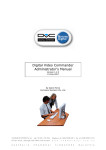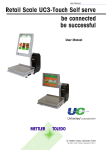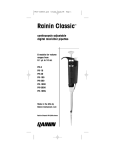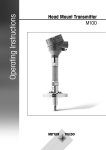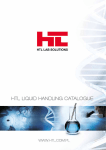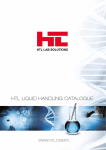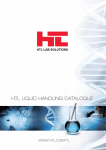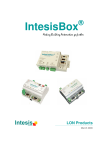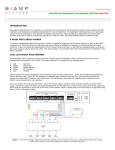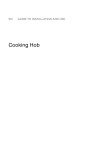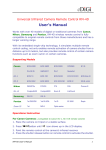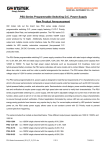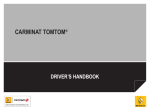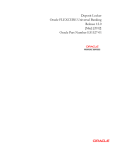Download Pipet-Lite - Mettler Toledo
Transcript
Pipet-Lite® Magnetic Assist Pipette continuously-adjustable digital microliter pipettes 11 pipettes for volume ranges from 0.1 µL to 20 mL Table of Contents Introduction ..................................................................1 Setting Volume..............................................................2 Filter ............................................................................3 Tip Selection and Mounting ............................................3 Tip Immersion Depth .....................................................4 Operation .....................................................................4 Pipetting Guidelines.......................................................5 Pre-Rinsing Recommended ............................................5 Reverse-Mode Pipetting .................................................5 Pipetting Liquids of Varying Density.................................6 Temperature Considerations ...........................................6 Autoclaving ..................................................................6 Tip Ejector Arm Removal ................................................7 Pipet-Lite Storage ..........................................................7 Troubleshooting and Repairs ..........................................8 Service, Calibration, and Repair ......................................9 Specifications .............................................................10 Replacement Parts ......................................................11 Contacting RAININ............................................Back Page Figures Figure 1 Figure 2 Figure 3 Pipet-Lite Pipette ........................................1 Filter Orientation.........................................3 Removing the Tip Ejector Arm......................7 Line Drawings Pipet-Lite Pipet-Lite Pipet-Lite Pipet-Lite Pipet-Lite Pipet-Lite Pipet-Lite Pipet-Lite Pipet-Lite Pipet-Lite Pipet-Lite 2 µL 10 µL 20 µL 100 µL 200 µL 300 µL 1000 µL 2000 µL 5000 µL 10 mL 20 mL ..................................................12 ..................................................12 ..................................................12 ..................................................12 ..................................................12 ..................................................12 ..................................................13 ..................................................13 ..................................................13 ..................................................13 ..................................................13 Contents of package Sample tips Pipet-Lite as ordered Instruction Manual Rainin Test Report Performance Assurance Brochure If any item is missing call Customer Service: 800-472-4646. Rainin, Pipet-Lite, LTS, are registered trademarks, and LiteTouch, Hang-Ups are trademarks of Rainin Instrument, LLC. Pipet-Lite pipettes are manufactured under U.S. Patent Nos. 5,614,153; 5,700,959; and 5,849,248. For use under U.S. patents 6,168,761 B1; 6,171,553 B1; and D426,643. Introduction Pipet-Lite is an air-displacement pipette which incorporates major ergonomic improvements to reduce the risk of repetitive strain injury and pain – low force seals and lower spring forces contribute to a lighter feel. A magnet is used to help sense and hold the piston in the zero position, which reduces static force on the operator’s hand. In the models with LTS™ shafts, the patented LiteTouch™ Tip Ejection System reduces total pipetting forces by up to 70%. Volume lock Plunger button / volume adjustment Tip ejector button Digital volume indicator Body: high-impact, low thermal conductivity polymer Tip ejector arm quick release Stainless steel tip ejector arm Shaft Disposable tip Figure 1 Pipet-Lite 200 µL 1 Setting Volume 1. Turn the volume lock counter-clockwise to the position shown at left below so the volume setting mechanism is unlocked and free to turn. 2. With the mechanism unlocked, orient Pipet-Lite so you are looking at the digital volume indicator, then rotate the plunger button to change volume – counter-clockwise to increase, and clockwise to decrease volume. The volume indicator is read from the top down. Red digits Black digits 2–20 µL: Black – µL. Red – tenths, hundredths of µL. 100–300 µL: All digits black – whole µL. 1000–5000 µL: Red – mL. Black – tenths, hundredths of mL. 10 mL: Red – mL. Black – tenths of mL 20 mL: Red – mL. Black – tenths of mL. 3. To eliminate errors due to mechanical backlash: when setting the desired volume, first turn the knob 1⁄3 turn above the desired volume. Then turn the knob slowly clockwise until the desired volume is displayed. Always dial down to the desired volume. 4. Turn the volume lock clockwise (see diagram above) to prevent accidental changes to the volume setting. Example volumes for the 200 µL model are shown below (note the intermediate setting at the right). 2 Volume ranges and increments are shown below: Pipet-Lite Volume 2 µL 10 µL 20 µL 100 µL 200 µL 300 µL 1000 µL 2000 µL 5000 µL 10 mL 20 mL Range (µL) Adjustable Recommended 0 to 2 0.1 to 2 0 to 10 0.5 to 10 0 to 20 2 to 20 0 to 100 10 to 100 0 to 200 20 to 200 0 to 300 30 to 300 0 to 1,000 100 to 1,000 0 to 2,000 200 to 2,000 0 to 5,000 500 to 5,000 0 to 10 mL 1 mL to 10 mL 0 to 20 mL 2 mL to 20 mL Increment µL 0.002 0.02 0.02 0.2 0.2 0.5 2.0 2.0 5.0 20.0 20.0 Filter Pipet-Lite 5000 µL, 10 mL, and 20 mL pipettes use a filter in the end of the shaft to help prevent liquid entering the shaft and contaminating the piston, should the plunger snap up during aspiration. Using such a filter is particularly important when pipetting large volumes. Replace the filter if it gets wet. Figure 2 Filter Orientation The 5000 µL and 10 mL pipettes use the same filter oriented as shown in the diagram above: 5000 µL: insert the small diameter into the shaft. 10 mL: insert the large diameter into the shaft. Filter part numbers are 6190-164 (pack of 100) and 6190165 (pack of 1000). The filter for 20 mL is a cylinder. Filter part numbers: 6190221 (pack of 100) and 6190-222 (pack of 500). Tip Selection and Mounting Always use RAININ tips with Pipet-Lite pipettes. Pipet-Lite pipettes are calibrated with RAININ tips, and performance to published specifications can only be guaranteed when RAININ tips are used. To mount a tip, press the Pipet-Lite shaft into the end of the tip with light force. The tip will seal properly on the shaft with minimal force — do not use more force than is required. 3 Tip Immersion Depth The recommended depth for tip insertion into the sample for each Pipet-Lite volume is shown below. Pipet-Lite 2 µL 10 µL 20 µL 100 µL 200 µL 300 µL 1000 µL 2000 µL 5000 µL 10 mL 20 mL Volume Range 0.1 - 2 µL 0.5 - 10 µL 2 - 20 µL 10 - 100 µL 20 - 200 µL 30 - 300 µL 100 - 1000 µL 200 - 2000 µL 500 - 5000 µL 1 mL - 10 mL 2 mL - 20 mL Immersion Depth 1-2 mm 1-2 mm 2 - 3 mm 2 - 3 mm 3 - 6 mm 3 - 6 mm 3 - 6 mm 3 - 6 mm 6 - 10 mm 6 - 10 mm 6 - 10 mm Tip immersion depth is critical. If these depths are exceeded, the volume measured may be inaccurate, possibly out of specification. Tip angle is also important. Hold the pipette within 20 degrees of vertical. Operation Before pipetting valuable samples, it is a good idea to practice aspirating and dispensing water before pipetting with actual samples. 1. Set the desired volume as described on page 2. 2. Attach a new RAININ tip. Press the shaft into the tip with only sufficient force to make a good seal. 3. Press the plunger button to the FIRST STOP, and hold it in this position. The magnetic assist will help you sense and hold this position. 4. Holding Pipet-Lite vertically, place the tip into the sample to the proper depth and relax your thumb pressure on the plunger. The light piston spring will move the piston upward, aspirating sample. Do not let go of the plunger button, or the piston may snap up quickly, resulting in inaccurate measurement. 5. Pause briefly (longer for macrovolume pipettes) to ensure that the full volume of sample is drawn into the tip. 6. Withdraw the tip from the sample. If any liquid remains on the outside of the tip, wipe it carefully with a lint-free tissue, taking care not to touch the tip orifice. 4 Dispensing: 1. Touch the tip end against the side wall of the receiving vessel and press the plunger slowly, past the FIRST STOP, to blowout (bottom of stroke.) Wait: 1 second for 2–300 µL volumes, 1-2 seconds for 1000 µL and larger. (Longer for viscous solutions.) 2. Still holding the plunger, withdraw the tip, sliding it along the wall of the vessel. Release the plunger. 3. Press the tip ejector button lightly to discard the tip. Use a new tip for each sample to prevent carry-over. Repeat for the next pipetting cycle. Pipetting Guidelines Pipet-Lite pipettes incorporate several new features which enhance pipetting consistency. You should also maintain: 1. Consistent pickup and dispense rhythm. 2. Consistent speed and smoothness when pipetting. 3. Consistent pressure on the plunger button at the FIRST STOP. 4. Consistent immersion depth. See table on page 4. 5. Pipette vertically, or within 20° of vertical. 6. Don’t invert or lay the pipette flat with liquid in the tip. Pre-Rinsing Recommended Some solutions may leave a film on the inside tip wall. This film remains relatively constant in successive pipettings with the same tip, so excellent precision can be obtained by refilling the tip and using the refilled volume as the sample. Successive samples from this same tip will exhibit good reproducibility. Reverse Mode Pipetting Another way of reducing error due to film retention, especially useful for more viscous liquids, is reverse mode pipetting. The operating sequence is reversed: 1. Mount a disposable tip on the pipette shaft. 2. Press the pushbutton fully to the SECOND STOP. 3. Immerse the tip in liquid and allow the button to return slowly to the fully UP position. Wait a moment for the liquid column to reach equilibrium in the tip. 5 4. Wipe any excess liquid from the outside of the tip without touching the orifice. 5. To dispense, rest the end of the tip against the vessel wall and press the plunger to the first stop. Hold this position a few seconds, or long enough for the liquid column to reach equilibrium again. 6. Remove the tip from the receiving vessel without blowing out the remaining liquid. 7. Return excess sample in the tip to the original sample container, if desired. Discard the used tip. Pipetting Liquids of Varying Density Pipet-Lite lets you compensate for solutions of density much different from water, by setting the volume slightly higher or lower than that required. The compensation amount must be determined empirically. For example, if pipetting 10 µL of CsCl solution, you determine that the volume delivered is actually 8.5 µL (≥5 samples). Change the volume setting to 11.8 µL and repeat the measurements. If the volumes delivered are still not close enough to 10 µL, make another slight volume adjustment until the measurements are as desired. Temperature Considerations Warm or cold liquids can be measured with good precision by using a consistent pipetting rhythm. This will help minimize any differences in heating or cooling effects within the pipette. Use a new tip each time for best accuracy and precision when measuring samples with temperatures greatly different from ambient, and do not pre-rinse. As with any air-displacement pipette, you will get best results if there is no delay between picking up the sample and dispensing it. Autoclaving Autoclavable parts of Pipet-Lite are the shaft and the tip ejector: 121°C, 1 bar, 15-20 minutes. Do not autoclave the complete pipette or any parts other than the shaft and the tip ejector. 6 Tip Ejector Arm Removal Three types of tip ejector are used and all types can be removed with minimum effort - do not use force. For models up to 2000 µL, press in the quick-release tabs on the ejector arm and pull the ejector down. For 5000 µL and 10 mL models, grasp the top of the ejector arm and pull outward then downward. For the 20 mL model, pull off the lower part of the ejector arm; the upper part stays in place. (Replace by aligning the rod with the hole in the upper part and pressing firmly.) To replace the ejector arm (except 20 mL), insert the shaft through the large opening, align the top with the tip ejector pushrod, and push until the ejector arm snaps in place. Figure 3 Removing the Tip Ejector Arm Pipet-Lite Storage After use, store the pipette in a clean safe place. Pipet-Lite is a precision instrument and should be treated with the level of care appropriate for laboratory instrumentation. Three types of hanger are available to hold your Pipet-Lite conveniently when not in use. CR-7: Free-standing carousel holds seven pipettes. HU-M3: Set of three individual magnetic Hang-Ups ™ for mounting on ferrous surfaces. HU-S3: Three Hang-Ups attached to a clamp which fits onto a shelf. 7 Troubleshooting and Repairs WARNING: When removing the shaft from the pipette body, make sure the spring, seal and o-ring do not fall off the piston, especially on the smaller models. Sample Splash (liquid inside the mechanism) 1. Remove the tip ejector arm. Also refer to the appropriate drawing on page 12 or 13. 2. On pipettes up to 1000 µL, unscrew the shaft coupling (B) and remove the shaft (C). For 2000 µL, unscrew the shaft. For 5000 µL, 10 mL and 20 mL unscrew the lower part of the shaft. Note the way the spring, seal and O-ring fit on the piston. 3. Inspect the seal assembly and piston for contamination. The piston should be shiny and free of corrosion. Clean with distilled water or isopropyl alcohol. Dry with a lintfree tissue and reassemble after inspecting the interior of the shaft for any contamination. For 5000 µL, 10 mL and 20 mL models, apply a small amount of grease to the seal. 4. If piston corrosion or staining is evident, do not use the instrument. Call 800-662-7027 for Service. Leaks, Inaccuracy, Abnormal Stroke 1. Loose shaft. Tighten coupling by hand. 2. Split or cracked shaft. Remove the tip ejector and inspect the shaft. Replace the shaft if necessary. If the shaft was dropped, remove it to see if the piston is bent. If so, return the instrument for service. 3. Worn seal and / or o-ring. All models up to 2000 µL incorporate a polyethylene seal and o-ring. Examine the seal and o-ring, replacing them as necessary. Pull off the old seal and o-ring, position the new seal and o-ring on the piston assembly as shown in the drawings on pages 12-13, and reassemble the pipette. Note: It is NOT necessary to recalibrate Pipet-Lite after changing seals. 4. Do not lubricate any components*. Pipet-Lite uses a dry sealing system. *Except 5000µL, 10 mL, and L-20ML models. These pipettes require a small amount of grease to be applied to the o-ring to make the seal. 8 Service, Calibration and Repair RAININ Pipette Repair and Calibration facilities: It is recommended to use only genuine RAININ replacement parts such as seals, o-rings, and shafts. It is NOT necessary to recalibrate the pipette after changing the seal, o-ring, or shaft. Recalibration of the pipette is only necessary when the piston is replaced, and should be done only by qualified factory-trained personnel in one of the above-mentioned facilities. For pipettes under warranty, please note that the warranty will be voided if the pipette has been damaged as a result of physical or chemical abuse, or if the pipette has been repaired or recalibrated by any service facility which is not authorized by Rainin. In the US, call 800-543-4030 for service. Or visit the web: www.rainin.com/service.asp. Service is also available outside the US. See the RAININ website home page, www.rainin.com, and click on the link “Customers outside North America”. METTLER TOLEDO Pipette Repair and Calibration facilities or authorized RAININ distributors who provide service can be found by following this link and specifying the country or geographical region. Contact Technical Support at 800-543-4030 for further information. 9 Specifications These manufacturer’s specifications should be used as guidelines when establishing your own performance specification. Pipet-Lite Specifications Volume Increment Model µL µL Accuracy % µL (±) % Precision µL (≤) 2 µL 0.2 1.0 2.0 0.002 12.0 2.7 1.5 0.024 0.027 0.030 6.0 1.3 0.7 0.012 0.013 0.014 10 µL 1.0 5.0 10.0 0.02 2.5 1.5 1.0 0.025 0.075 0.1 1.2 0.6 0.4 0.012 0.03 0.04 20 µL 2 10 20 0.02 7.5 1.5 1.0 0.15 0.15 0.2 2.0 0.5 0.3 0.04 0.05 0.06 100 µL 10 50 100 0.2 3.5 0.8 0.8 0.35 0.4 0.8 1.0 0.24 0.15 0.1 0.12 0.15 200 µL 20 100 200 0.2 2.5 0.8 0.8 0.5 0.8 1.6 1.0 0.25 0.15 0.2 0.25 0.3 300 µL 30 150 300 0.5 2.5 0.8 0.8 0.75 1.2 2.4 1.0 0.25 0.15 0.3 0.375 0.45 1000 µL 100 500 1000 2 3.0 0.8 0.8 3.0 4.0 8.0 0.6 0.2 0.15 0.6 1.0 1.5 2000 µL 200 1000 2000 2 3.0 0.8 0.8 6.0 8.0 16.0 0.6 0.2 0.12 1.2 2.0 2.4 5000 µL 500 2500 5000 5 2.4 0.6 0.6 12.0 15.0 30.0 0.6 0.2 0.16 3.0 5.0 8.0 10 mL 1 mL 5 mL 10 mL 20 5.0 1.0 0.6 50.0 50.0 60.0 0.6 6.0 0.2 10.0 0.16 16.0 20 mL 2 mL 10 mL 20 mL 20 5.0 100.0 1.0 100.0 0.6 120.0 0.6 12.0 0.2 20.0 0.16 32.0 Specifications are subject to change without notice. Acids and Corrosives After pipetting concentrated acids or highly corrosive solutions, disassemble Pipet-Lite and inspect and clean the piston assembly, shaft, and seal with distilled water. Dry all components thoroughly and reassemble. Extensive contact with corrosive fumes may result in premature seal wear and damage to the piston. Exposure of internal components to corrosive fumes can be reduced by using RAININ tips with aerosol barrier filters. 10 Replacement Parts (see pages 12-13) Legend for Pipet-Lite 2 µL to 2000 µL B- Shaft Coupling A - Plunger Button E - Piston Assembly D - Tip Ejector* H - Stroke Spring G - O-ring C - Shaft* F - Seal J - Seal Retainer L- Series: note the second set of A and B (shaded) are for the new-handle Pipet-Lite (2007) L-2 A 6202-055 A 6202-500 B 6202-062 B 6202-499 C 6202-063 D 6202-071 E 6202-076 F 6200-131 G 6200-132 H 6202-083 J 6200-196 L-10 6202-056 6202-501 6202-062 6202-499 6202-064 6202-071 6202-077 6200-138 6200-139 6202-083 6200-196 L-20 6202-057 6202-502 6202-062 6202-499 6202-065 6202-071 6202-078 6200-143 6200-170 6202-083 6200-198 L-100 6202-058 6202-504 6202-062 6202-499 6202-066 6202-073 6202-079 6200-150 6200-151 6202-084 6200-201 L-200 6202-059 6202-505 6202-062 6202-499 6202-067 6202-073 6202-080 6200-154 6200-155 6202-084 6200-200 L-300 6202-306 6202-506 6202-062 6202-499 6202-425 6200-419 6202-427 6200-415 6200-414 6202-084 6200-416 L-1000 6202-060 6202-507 6202-062 6202-499 6202-068 6202-074 6202-081 6200-161 6200-162 n/a n/a L-2000 6202-192 6202-509 n/a n/a 6202-214 6200-168 6202-082 6200-166 6200-167 n/a n/a SL- Series: note the second set of A and B (shaded) are for the new-handle Pipet-Lite (2007) SL-2 A 6202-109 A 6202-516 B 6202-062 B 6202-515 C 6200-134 D 6200-133 E 6202-183 F 6200-131 G 6200-132 H 6202-083 J 6200-196 SL-10 6202-110 6202-517 6202-062 6202-515 6200-140 6200-133 6202-184 6200-138 6200-139 6202-083 6200-196 SL-20 6202-111 6202-518 6202-062 6202-515 6200-145 6200-144 6202-185 6200-143 6200-170 6202-083 6200-198 SL-100 6202-112 6202-519 6202-062 6202-515 6200-147 6200-148 6202-079 6200-150 6200-151 6202-084 6200-201 SL-200 6202-113 6202-520 6202-062 6202-515 6200-157 6200-156 6202-080 6200-154 6200-155 6202-084 6200-200 SL-300 6202-426 6202-521 6202-062 6202-515 6200-413 6200-419 6202-427 6200-415 6200-414 6202-084 6200-416 SL-1000 6202-114 6202-522 6202-062 6202-515 6200-160 6200-163 6202-081 6200-161 6200-162 n/a n/a SL-2000 6202-115 6202-523 n/a n/a 6200-169 6200-168 6202-082 6200-166 6200-167 n/a n/a * These parts are autoclavable (C - shaft, D - tip ejector arm) Legend for Pipet-Lite 5000 µL , 10 mL and 20 mL A - Plunger Button C- Tip Ejector* D - Piston Assembly E - Piston O-ring F - Cylinder G - Cylinder O-ring H - Shaft* L- Series: SL- Series: L-5000 L-10ML L-20ML SL-5000 SL-10ML A 6202-193 6202-194 6202-297 6202-217 6202-218 A 6202-510 6202-511 6202-512 6202-524 6202-525 C 6200-373 6200-374 6202-298 6200-373 6200-374 D 6202-215 6202-216 6202-296 6202-215 6202-216 E 6200-363 6200-369 6202-299 6200-363 6200-369 F 6200-365 6200-371 6202-301 6200-365 6200-371 G 6200-364 6200-370 6202-300 6200-364 6200-370 H 6202-222 6202-223 6202-302 6200-362 6200-368 * These parts are autoclavable (C - tip ejector arm, H - shaft) Common parts for 5000 µL, 10 mL, and 20 mL: Tube of grease: 6100-555 Filters for 5000 µL/10 mL: 6190-164 (100), 6190-165 (1000) Filters for 20 mL: 6190-221 (100), 6190-222 (500) 11 Pipet-Lite 2 & 10 µL Pipet-Lite 20 µL A A H H B B J J F G F G C C E E D D Pipet-Lite 200 & 300 µL Pipet-Lite 100 µL A A H H B J J B F G F G E E C C D D Legend for Pipet-Lite 2 µL to 2000 µL Models (this page and top of next page) A - Plunger Button D - Tip Ejector G - O-ring 12 B- Shaft Coupling E - Piston Assembly H - Stroke Spring C - Shaft F - Seal J - Seal Retainer Pipet-Lite 1000 µL Pipet-Lite 2000 µL A A F G F G B E E C C D D Legend for Pipet-Lite 5000 µL, 10 mL and 20 mL (below) A - Plunger Button E - Piston O-ring H - Shaft C- Tip Ejector Arm F- Cylinder Pipet-Lite 5000 µL & 10 mL D - Piston Assembly G - Cylinder O-ring Pipet-Lite 20 mL A A D D E E F F G G H H C C 13 Limited Warranty See the Limited Warranty and Limitations of Liability Statement. Please complete and return the Warranty Registration Card on receipt of your pipette. RAININ pipettes are calibrated with RAININ tips. To assure excellent reproducibility and performance, use only RAININ tips as recommended in this manual. Specified performance is guaranteed only when RAININ tips are used. Contacting RAININ Technical Information: F: 510-564-1617 T: 800-543-4030 Pipette Service: T: 800-662-7027 F: 781-935-7631 Direct Order Line: T: 800-472-4646 F: 510-564-1617 RAININ website: www.rainin.com [email protected] [email protected] [email protected] From outside North America: T: +1-510-564-1600 [email protected] (from outside the U.S.) METTLER TOLEDO Offices METTLER TOLEDO website: www.mt.com/rainin Mettler-Toledo (Schweiz) GmbH, Im Langacher , 8606 Greifensee CH Verkauf 044 944 45 45 [email protected] Service 044 944 47 47 [email protected] Mettler Toledo GmbH, Ockerweg 3 , 35396 Giessen DE Verkauf +49 641 507 222 [email protected] Service +49 641 507 307 [email protected] Mettler-Toledo SAS, 18-20 avenue de la Pépinière , 78220 Viroflay FR Ventes 01 30 97 17 17 [email protected] Laboratoire d'Etalonnage Accrédité, 264 rue Abraham Lincoln Service Pipette, 62400 Bethune FR Service 03 21 64 54 66 [email protected] N.V. Mettler-Toledo S.A., Leuvensesteenweg 384 , 1932 Zaventem BE Sales +32 2334 0211 [email protected] Service +32 2334 0211 [email protected] Mettler-Toledo S.A.E., Miguel Hernández 69-71 , 08908 L'Hospitalet de Llobregat (Barcelona) ES Ventas 0034 93 223 7666 [email protected] Servicio Técnico 0034 93 223 7666 [email protected] Mettler-Toledo A/S, Naverland 8 , 2600 Glostrup DK Salg 43 27 08 25 [email protected] Service 43 27 08 25 [email protected] Rainin Instrument, LLC 7500 Edgewater Drive, Box 2160, Oakland, CA 94621-0060 a METTLER TOLEDO Company Prices and specifications are subject to change without notice. Copyright 2007, Rainin Instrument, LLC. ISO 9001:2000 REGISTERED 9920-237 Rev M


















